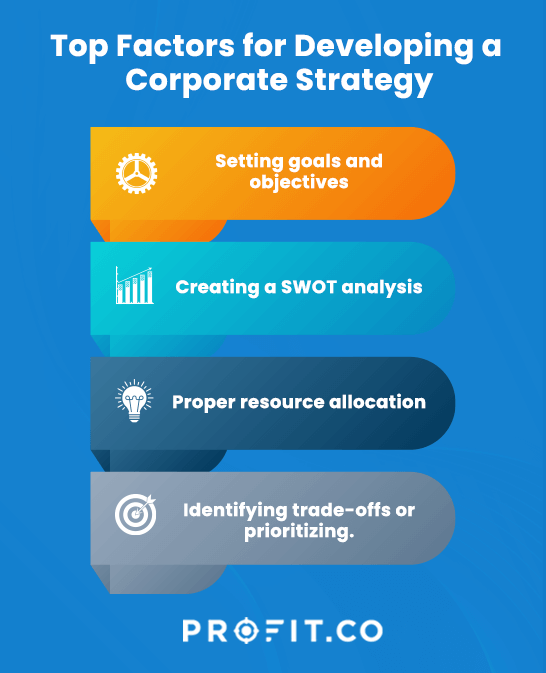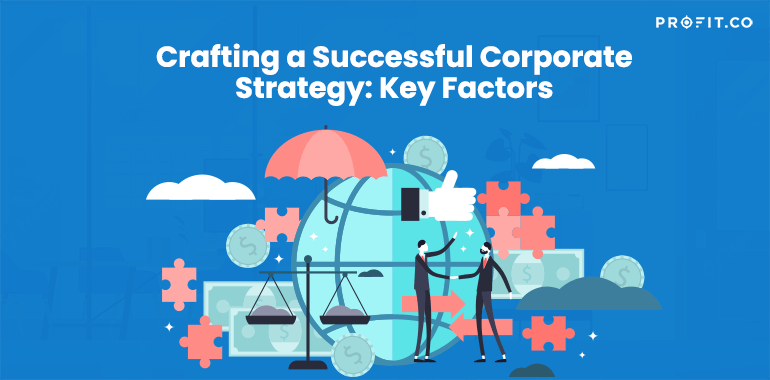Introduction
So, what is corporate strategy, and why is it important? A corporate strategy is a strategic guide that helps organizations focus on long-term goals. It provides the agility to respond to developments and market changes.
A corporate strategy involves the entire business or company, influencing future direction and growth decisions. It aims to maximize the market share and give the business a unique competitive edge while building value.
Although a corporate strategy can make or break your business or company, developing a successful one doesn’t have to be daunting. So, what’s the secret? This guide explores the critical considerations when crafting a corporate strategy to ensure success.
Understand Your Business Environment
A comprehensive understanding of your business environment is essential to developing an effective corporate strategy. By analyzing the market landscape and assessing your competition, you can identify gaps and opportunities that will enable you to cultivate a strategy that enhances your business’s competitive edge.
Understanding your business environment involves conducting thorough market research to identify emerging trends, customer preferences, and potential areas for growth. You can proactively respond and adapt your strategy by staying attuned to your target market’s evolving needs and demands.
Additionally, analyzing your competition provides valuable insights into its strengths, weaknesses, and market positioning. By evaluating their offerings, market share, customer satisfaction, and business practices, you can pinpoint areas where you can differentiate yourself and capitalize on their vulnerabilities.
Evaluate the competitive landscape in your market by finding out the following:
- What unfulfilled needs can you take advantage of and establish a niche market?
- What differentiates your products or services from competing companies?
- Which companies have larger market shares?
Conducting this research will help you determine where to create opportunities and how to offer unique customer value.
Manage the top line: your strategy, your people, and your products, and the bottom line will follow.
Define Clear Goals and Objectives
Establishing clear objectives and goals is pivotal in understanding the purpose of your business. It serves as a guiding force throughout the planning process, ensuring your corporate strategy remains aligned with your core values and vision.
It is essential to distinguish between a corporate strategy and a business strategy. While a business strategy focuses on market competition, a corporate strategy prioritizes profits and overall business growth.
When setting goals and objectives, they must transcend mere statements of intentions. They should be firm, concise, and definitive declarations that articulate the fundamental reason behind your business’s existence and steer all your actions and decisions.
These objectives become the foundation of your strategy, outlining your goals and setting specific milestones and deadlines to track your progress. By defining clear objectives, you provide a roadmap for your business’s trajectory and create a framework for evaluating success and making informed decisions.
It is essential to regularly revisit and reassess your objectives to ensure they remain relevant and aligned with the dynamic nature of your business environment. By continuously evaluating and refining your goals, you can adapt to changing circumstances, seize emerging opportunities, and overcome challenges effectively.
Let’s work together to implement a winning corporate strategy and achieve your business goals.
Conduct a SWOT Analysis
Every growing business or company requires a sound corporate strategy that helps everyone remain focused on the long-term objectives and goals. It also simplifies responding to threats, opportunities, and resource allocation decisions.
A key element of crafting successful corporate-level strategies is SWOT analysis. SWOT represents strengths, weaknesses, opportunities, and threats.
- Strengths
- Weaknesses
- Opportunities
- Threats
The first step is identifying the strengths that give your business a competitive edge, such as your reputation, location, and customer base.
The most challenging yet crucial thing is to ensure your competitive edge is sustainable, such as discovering how to use your strengths in ways your competitors can’t duplicate and ways that external changes can’t diminish their value.
The next step is determining your company’s weaknesses. These areas, such as poor customer support or inadequate resources, prevent you from achieving your objectives and goals. Seeing how external factors can affect your strategy becomes easier once you figure out how to sustain your competitive edge.
Clarifying weaknesses simplifies identifying growth opportunities to drive you toward your goals.
Opportunities are favorable external factors that propel your business or company to success. Recognizing and identifying opportunities within your environment, industry, or market is crucial for maximizing their benefits to your business.
Start by comprehensively analyzing your business environment to identify potential opportunities by examining market trends, consumer demands, technological advancements, regulatory changes, and emerging gaps in the market.
Furthermore, assess your industry landscape to identify opportunities for growth and expansion. Look for untapped market segments, underserved customer needs, or areas where your business can differentiate itself from competitors. Analyze your competitive advantages and how to seize these opportunities effectively.
It is essential to identify both internal and external threats to your organization. Beyond your immediate control, these factors pose risks that must be acknowledged and managed effectively. Examples of threats include evolving industry regulations, shifting customer demand, and new competitors.
You gain valuable insights to develop contingency plans by actively identifying and assessing these threats. These plans serve as proactive measures to address and mitigate the potential impact of threats should they materialize. Having contingency plans empowers your organization to respond swiftly and effectively, minimizing potential disruptions and maintaining business continuity.

Evaluate Strategic Options
Strategic options are the different action plans you can implement to help your company or business attain long-term objectives and goals. These options should align with the purpose of your business.
Your evaluation should examine four criteria, including:
1. Strategic fit
Strategic fit determines the future appeal of a particular option. You can use several techniques to assess the strategic fit, such as:
- Cross-checking every option against the weaknesses and strengths highlighted in your SWOT analysis
- Cross-checking every choice against the threats and opportunities, like industry trends and regulations
- Cross-checking your options against existing scenarios to see which one has positive outcomes in all scenarios
- Weighing every option against your strategic objectives and goals to see which one has the most significant contribution
2. Feasibility
Feasibility determines the ease of implementing an option. The best way to determine this is by cross-checking your options against the weaknesses and strengths identified by the SWOT analysis. Consider questions such as:
- Will the option prevent you from succumbing to your weaknesses?
- Will it involve your weak points or require strengths you lack?
- Would the option give you a unique advantage over competitors without those strengths?
- Does the option optimize your strengths?
3. Interdependencies
In strategic decision-making, it is crucial to recognize that specific options are independent while others are interconnected. Mutual exclusions arise when pursuing one strategic option hinders or conflicts with another. Making tough choices and prioritizing one option over another may be necessary due to limited resources, conflicting goals, or incompatible strategies. This recognition allows for a focused approach that avoids diluting efforts and resources, ensuring more effective execution of the chosen direction.
In addition to mutual exclusions, strategic options can also exhibit dependencies. Dependencies occur when the implementation of one option facilitates or enables the execution of another. In this scenario, pursuing one strategic option can create a synergistic effect, making pursuing related opportunities easier or more advantageous. Recognizing and leveraging these dependencies allows for a more cohesive and interconnected approach to strategy execution.
4. Financial reward and risk
Financial reward and risk play crucial roles in assessing the costs, risks, and potential gains of implementing a strategic option. Evaluating the magnitude of threats and rewards helps organizations make informed decisions about the viability and feasibility of different options.
Assessing financial reward involves estimating the potential gains and benefits achieved by implementing a specific option. This evaluation considers increased revenue, market share growth, cost savings, and improved profitability. Understanding the financial rewards helps organizations prioritize options that offer higher potential returns.
Conversely, evaluating financial risk involves identifying and analyzing the potential costs, drawbacks, and uncertainties of implementing an option. This assessment considers upfront investments, ongoing operational costs, market volatility, competitive challenges, and potential regulatory or legal risks. Recognizing the financial risks allows organizations to assess and prepare.
You can assess financial reward and risk through the Profitability Index, Net Present Value (NPV), and Internal Rate of Return (IRR).
FAQs
1. What factors should you consider when developing a corporate strategy?
A comprehensive corporate strategy has several key components: setting goals and objectives, SWOT analysis, resource allocation, and identifying trade-offs or prioritizing.
2. What factors can impact strategy success?
Some factors that determine the success of strategy implementation include:
- Setting realistic delivery goals for a set period
- Having an environment that promotes strategy success
- Aligning the strategy with the company culture or organizational structure
- Committing to the strategy
3. What are strategic options?
Strategic options are the different action plans you can implement to help your company or business attain long-term objectives and goals. These options should align with the purpose of your business.
Conclusion
Corporate strategic planning equips your business or company with essential tools to thrive in competitive markets. By crafting well-structured corporate-level strategies, you can unlock quantifiable benefits while gaining valuable insights into your business operations.
Following the guidelines above, you can develop robust corporate strategies that pave the way for success. These strategies align with corporate-level goals, prioritize profitability, and fuel accelerated growth. By consistently evaluating and refining your corporate strategy, you can adapt to changing market dynamics, capitalize on emerging opportunities, and navigate competitive challenges effectively.

